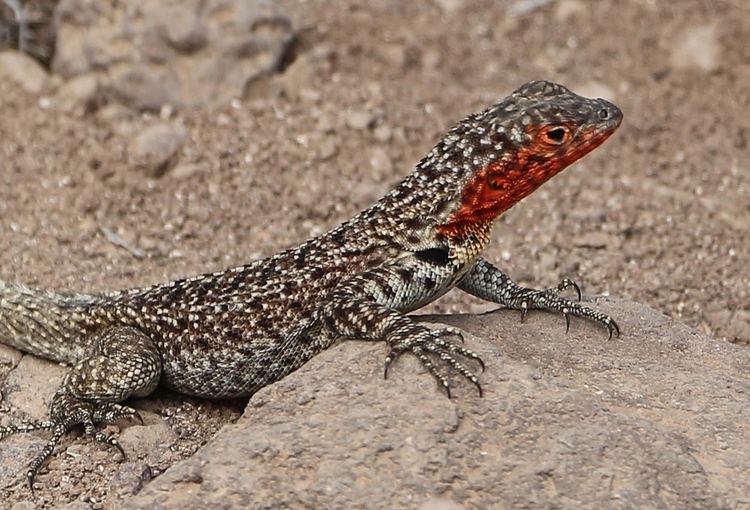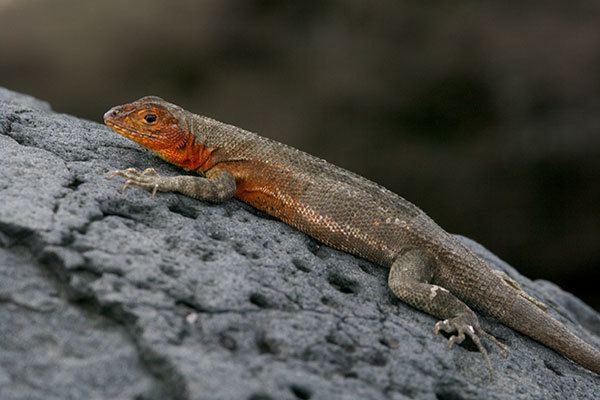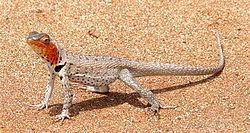Suborder Lacertilia Phylum Chordata Rank Species | Class Reptilia Order Scaled reptiles | |
Similar Microlophus, Microlophus delanonis, Tropidurus, Scaled reptiles, Tropiduridae | ||
Galapagos lava lizard microlophus albemarlensis
The Galápagos lava lizard (Microlophus albemarlensis), also known as the Albemarle lava lizard, is a species of lava lizard endemic to the Galápagos Islands, where it occurs on several islands in the western archipelago: the large islands Isabela, Santa Cruz, Fernandina, Santiago and Santa Fe, as well as several smaller islands: Seymour, Baltra, Plaza Sur, Daphne Major and Rábida. It is the most widespread of the Galápagos species of Microlophus, the others only occurring on single islands. Some authors however, consider populations on Santiago, Santa Cruz, and Santa Fe (and associated small islands) to be distinct species (M. jacobi, M. indefatigabilis and M. barringtonensis, respectively). The species is commonly attributed to the genus Microlophus but has been historically placed in the genus Tropidurus.
Contents
- Galapagos lava lizard microlophus albemarlensis
- Description
- Reproduction
- Activity and aggression
- Diet
- Classification
- References

Description

Adult Galápagos lava lizards range from around 50 to 100 mm long SVL (snout-to-vent length; excluding tail which can be equal or longer to SVL), with average and maximum sizes varying between islands. Males are on average larger than females, being twice to three times as heavy, with average body sizes of 77 to 91 mm SVL, compared to 63–71 mm of females. In addition to size, there are significant color and morphological differences between sexes, although color varies across islands. Males are blue gray to brownish, spotted black to ash gray, and tend to have dark crossbands on the neck and anterior portion of the back. The throat has a large black blotch, extending to the base of the forelimbs. Males have a crest of spined scales running down the length of the body, which are longer than those of females. Males also have proportionally longer hind legs.

Females are largely unmarked or have light speckles, and lack the dark crossbars of males, although may have dark banding on tail, especially young females. Adult females lack the black throat blotch of males, and instead have a distinctive "cheek patch": a patch of salmon, orange, or brick red extending from the base of the front legs to the snout, and up to the eye. The cheek patch appears as females attain reproductive maturity.
Reproduction
Prior to mating, males seize the skin of the necks or backs of females in their jaws, and sometimes carry them short distances before mating. Females lay clutches of 1 to 6 white, leathery, elliptical eggs, with larger clutches generally occurring in larger females. On Santa Cruz Island, 2 eggs is most common. Females have been observed digging short burrows to lay eggs in May and June.
Activity and aggression
Galápagos lava lizards are active during the day, emerging around sunrise, withdrawing during the heat of midday, and resuming activity in the afternoon. At night they burrow under soil or leaf-litter, submerged up to 12 mm (1.5 inches), often returning to the same resting area each night.

Males are territorial, with home ranges averaging around 22 meters in diameter, and defend their ranges against other males with threat displays and fighting. Females have smaller home ranges of around 13 meters diameter, and a single male's home range may overlap with the ranges of several females. Threat displays include holding the body erect, flattening the sides of the body, positioning the broad side of the body towards the opponent, and bobbing. Males tend to exhibit threat displays towards juveniles and smaller males but not to females, while females will exhibit threat displays towards other females and juveniles.
Diet
Galápagos lava lizards feed on insects, spiders, and other arthropods, with maggots (fly larvae), ants, and beetles being most common prey items. Around human settlements they will also consume bread crumbs, meat scraps and other litter. Fragments of leaves and flowers, as well as large seeds, have been found in the stomachs, and lizards have been observed in trees consuming freshly sprouted leaves as high as 2.1 m (7 ft) off the ground.
Classification

The Galápagos lava lizard was first described by Georg Baur in 1890, who named it Tropidurus albemarlensis after Albemarle, the alternate name of Isabela Island. In the same paper he described T. indefatgiabilis from Santa Cruz Island (alternately known as Indefatigable Island). In 1992 Darrel Frost transferred all species of Tropidurus west of the Andes Mountains into Microlophus (formerly regarded as a subgenus of Tropidurus), based on a number of characteristics, the unique defining trait (synapomorphy) being discs on the tips of the male reproductive organs (hemipenes). Some populations of Microlophus albemarlensis on different islands have been regarded as different species (or "candidate species") based on genetic differences, although no unique morphological differences are known. The recognition of M. jacobi, M. indefatigabilis and M. barringtonensis as distinct species is not widely accepted. The lava lizards are within the Tropiduridae, a family of South American lizards.
